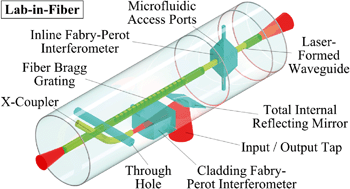Chemical-assisted femtosecond laser writing of lab-in-fibers
Abstract
The lab-on-chip (LOC) platform has presented a powerful opportunity to improve functionalization, parallelization, and miniaturization on planar or multilevel geometries that has not been possible with fiber optic technology. A migration of such LOC devices into the optical fiber platform would therefore open the revolutionary prospect of creating novel lab-in-fiber (LIF) systems on the basis of an efficient optical transport highway for multifunctional sensing. For the LIF, the core optical waveguide inherently offers a facile means to interconnect numerous types of sensing elements along the optical fiber, presenting a radical opportunity for optimizing the packaging and densification of diverse components in convenient geometries beyond that available with conventional LOCs. In this paper, three-dimensional patterning inside the optical fiber by femtosecond laser writing, together with selective chemical etching, is presented as a powerful tool to form refractive index structures such as optical waveguides and gratings as well as to open buried microfluidic channels and optical resonators inside the flexible and robust glass fiber. In this approach, optically smooth surfaces (~12 nm rms) are introduced for the first time inside the fiber cladding that precisely conform to planar nanograting structures when formed by aberration-free focusing with an oil-immersion lens across the cylindrical fiber wall. This process has enabled optofluidic components to be precisely embedded within the fiber to be probed by either the single-mode fiber core waveguide or the laser-formed optical circuits. We establish cladding waveguides, X-couplers, fiber Bragg gratings, microholes, mirrors, optofluidic resonators, and microfluidic reservoirs that define the building blocks for facile interconnection of inline core-waveguide devices with cladding optofluidics. With these components, more advanced, integrated, and multiplexed fiber microsystems are presented demonstrating fluorescence detection, Fabry–Perot interferometric refractometry, and simultaneous sensing of refractive index, temperature, and bending strain. The flexible writing technique and multiplexed sensors described here open powerful prospects to migrate the benefits of LOCs into a more flexible and miniature LIF platform for highly functional and distributed sensing capabilities. The waveguide backbone of the LIF inherently provides an efficient exchange of information, combining sensing data that are attractive in telecom networks, smart catheters for medical procedures, compact sensors for security and defense, shape sensors, and low-cost health care products.


 Please wait while we load your content...
Please wait while we load your content...